Chapter 7: Budgeting
Chapter learning objectives
Upon completion of this chapter you will be able to:
- explain why organisations use budgeting
- explain how budgetary systems fit within the performance hierarchy
- describe the factors which influence behaviour at work
- discuss the issues surrounding setting the difficulty level for a budget
- explain the benefits and difficulties of the participation of employees in the negotiation of targets
- explain how corporate and divisional objectives may differ and can be reconciled
- identify and resolve conflicting objectives, explaining the implications of the conflict and method of resolution.
- explain and evaluate ‘top down' and ‘bottom up' budgetary systems; ‘rolling', ‘activity-based', 'incremental' and 'zero-based' budgetary systems.
- explain and evaluate ‘feed-forward' budgetary control
- select and justify an appropriate budgetary system for a given organisation
- describe the information used in various budgetary systems and the sources of the information needed
- explain the difficulties of changing a budgetary system and type of budget used
- explain how budget systems can deal with uncertainty in the environment
- explain the major benefits and dangers in using spreadsheets in budgeting.

1 Purpose of budgets
A budget is a quantitative plan prepared for a specific time period. It is normally expressed in financial terms and prepared for one year.
Budgeting serves a number of purposes:
- Planning
A budgeting process forces a business to look to the future. This is essential for survival since it stops management from relying on ad hoc or poorly co-ordinated planning.
- Control
Actual results are compared against the budget and action is taken as appropriate.
- Communication
The budget is a formal communication channel that allows junior and senior managers to converse.
- Co-ordination
The budget allows co-ordination of all parts of the business towards a common corporate goal.
- Evaluation
Responsibility accounting divides the organisation into budget centres, each of which has a manager who is responsible for its performance. The budget may be used to evaluate the actions of a manager within the business in terms of the costs and revenues over which they have control.
- Motivation
The budget may be used as a target for managers to aim for. Reward should be given for operating within or under budgeted levels of expenditure. This acts as a motivator for managers.
- Authorisation
The budget acts as a formal method of authorisation to a manager for expenditure, hiring staff and the pursuit of plans contained within the budget.
- Delegation
Managers may be involved in setting the budget. Extra responsibility may motivate the managers. Management involvement may also result in more realistic targets.
2 Budgets and performance management
Budgets contribute to performance management by providing benchmarks against which to compare actual results (through variance analysis), and develop corrective measures. They take many forms and serve many functions, but most provide the basis for :
- detailed sales targets
- staffing plans
- production
- cash investment and borrowing
- capital expenditure
Budgets give managers "preapproval" for execution of spending plans, and allow them to provide forward looking guidance to investors and creditors. For example, budgets are necessary to convince banks and other lenders to extend credit.
Even in a small business, an robust business plan/budget can often result in anticipating and avoiding disastrous outcomes.
Medium and larger organisations invariably rely on budgets. This is equally true in businesses, government, and not-for-profit organizations. The budget provides a formal quantitative expression of expectations. It is an essential facet of the planning and control process. Without a budget, an organisation will be highly inefficient and ineffective.

 Test your understanding 1 - Evaluation of managers
Test your understanding 1 - Evaluation of managers
A wage award for production staff is agreed which exceeds the allowance incorporated in the budget. Discuss whether the performance of the production manager should be linked to the wage cost.

3 The performance hierarchy
As you may recall from paper F1, firms have a planning hierarchy:
- Strategic planning is long term, looks at the whole organisation and defines resource requirements. For example, to develop new products in response to changing customer needs.
- Tactical planning is medium term, looks at the department / divisional level and specifies how to use resources. For example, to train staff to deal with the challenges that this new product presents.
- Operational planning is very short term, very detailed and is mainly concerned with control. Most budgeting activities fall within operational planning and control. For example, a budget is set for the new product to include advertising expenditure, sales forecasts, labour and material expenditure etc.
The aim is that if a manager achieves short-term budgetary targets (operational plans) then there is more chance of meeting tactical goals and ultimately success for strategic plans.
The achievement of budgetary plans will impact on the eventual achievement of the tactical and strategic plans. However, budgets should also be flexible in order to meet the changing needs of the business.
4 Behavioural aspects of budgeting
Individuals react to the demands of budgeting and budgetary control in different ways and their behaviour can damage the budgeting process.
Behavioural problems are often linked to management styles, and include dysfunctional behaviour and budget slack.
Management styles (Hopwood)
Research was carried out by Hopwood (1973) into the manufacturing division of a US steelworks, involving a sample of more than 200 managers with cost centre responsibility. Hopwood identified three distinct styles of using budgetary information to evaluate management performance.

5 Setting the difficulty level of a budget
Budgetary targets will assist motivation and appraisal if they are at the right level.
An expectations budget is a budget set at current achievable levels. This is unlikely to motivate managers to improve but may give more accurate forecasts for resource planning, control and performance evaluation.
An aspirations budget is a budget set at a level which exceeds the level currently achieved. This may motivate managers to improve if it is seen as attainable but may also result in an adverse variance if it is too difficult to achieve. This must be managed carefully.

 Test your understanding 2
Test your understanding 2
A manager is awarded a bonus for achieving monthly budgetary targets. State three possible behavioural implications of this policy. What should be done to try to improve the process?


 Test your understanding 3
Test your understanding 3
A sales manager has achieved $550,000 of sales in the current year. Business is expected to grow by 10% and price inflation is expected to be 3%.
Suggest a suitable budget target for the forthcoming year.

6 Conflicting objectives
There are many examples of conflicting objectives that occur in budgeting. The illustration below identifies some common conflicts and explains how they can be resolved.

 Illustration 1 – Conflicting objects
Illustration 1 – Conflicting objects
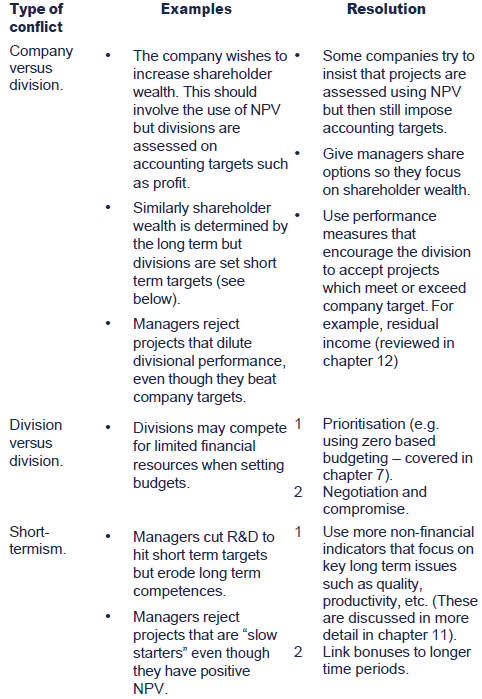
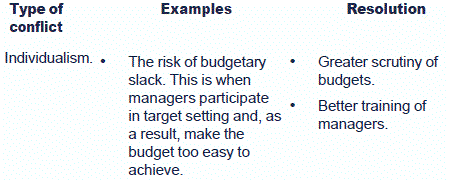


 Test your understanding 4
Test your understanding 4
A manager is planning to retire at the end of the current period. His final bonus is based on the performance of his division for the period.
Required:
Suggest some performance management issues this raises and how they can be resolved.

7 Approaches to budgeting
Introduction
There are a number of different budgetary systems:
- Top down vs bottom up budgeting
- Incremental budgeting
- Zero-based budgeting (ZBB)
- Rolling budgets
- Activity-based budgeting
- Feed-forward control
Each system will be reviewed in turn.
Top down and bottom up budgeting
 A top down budget is a budget that is set without allowing the ultimate budget holder to have the opportunity to participate in the budgeting process.
A top down budget is a budget that is set without allowing the ultimate budget holder to have the opportunity to participate in the budgeting process.
 A bottom up budget is a system of budgeting in which budget holders have the opportunity to participate in setting their own budgets. Also called participative budgeting.
A bottom up budget is a system of budgeting in which budget holders have the opportunity to participate in setting their own budgets. Also called participative budgeting.


 Test your understanding 5
Test your understanding 5
Bottom up budgeting is generally seen as preferable because it leads to improved managerial motivation and performance. However, there are situations for which top down budgeting is preferable.
Describe three situations where top down budgeting would be more applicable.

 Incremental budgets
Incremental budgets
An incremental budget starts with the previous period's budget or actual results and adds (or subtracts) an incremental amount to cover inflation and other known changes.
It is suitable for stable businesses, where costs are not expected to change significantly. There should be good cost control and limited discretionary costs.


 Test your understanding 6
Test your understanding 6
AW Inc produces two products, A and C. In the last year (20X4) it produced 640 units of A and 350 units of C incurring costs of $672,000. Analysis of the costs has shown that 75% of the total costs are variable. 60% of these variable costs vary in line with the number of A produced and the remainder with the number of C.
The budget for the year 20X5 is now being prepared using an incremental budgeting approach. The following additional information is available for 20X5:
- All costs will be 4% higher than the average paid in 20X4.
- Efficiency levels will remain unchanged.
- Expected output of A is 750 units and of C is 340 units.
What is the budgeted total variable cost of products A and C for the full year 20X5?

Zero-based budgeting
A ‘method of budgeting that requires each cost element to be specifically justified, as though the activities to which the budget relates were being undertaken for the first time. Without approval, the budget allowance is zero'
It is suitable for:
- allocating resources in areas were spend is discretionary, i.e. non-essential. For example, research and development, advertising and training.
- public sector organisations such as local authorities.
There are four distinct stages in the implementation of ZBB:
(1) Managers should specify, for their responsibility centres, those activities that can be individually evaluated.
(2) Each of the individual activities is then described in a decision package. The decision package should state the costs and revenues expected from the given activity. It should be drawn up in such a way that the package can be evaluated and ranked against other packages.
(3) Each decision package is evaluated and ranked usually using cost/benefit analysis.
(4) The resources are then allocated to the various packages.


 Additional information on decision packages
Additional information on decision packages
A decision package was defined by Peter Pyhrr (who first formulated the ZBB approach at Texas Instruments) as:
A document that identifies and describes a specific activity in such a manner that senior management can:
(a) evaluate and rank it against other activities competing for limited resources, and
(b) decide whether to approve or disapprove it.'
A decision package is a document that:
- analyses the cost of the activity (costs may be built up from a zero base, but costing information can be obtained from historical records or last year's budget)
- states the purpose of the activity
- identifies alternative methods of achieving the same purpose
- assesses the consequence of not doing the activity at all, or performing the activity at a different level
- establishes measures of performance for the activity.
Pyhrr identifies two types of package.
(i)Mutually exclusive packages: these contain different methods of obtaining the same objective.
(ii) Incremental packages: these divide the activity into a number of different levels of activity. The base package describes the minimum effort and cost needed to carry out the activity. The other packages describe the incremental costs and benefits when added to the base.
For example, a company is conducting a ZBB exercise, and a decision package is being prepared for its materials handling operations.
- The manager responsible has identified a base package for the minimum resources needed to perform the materials handling function. This is to have a team of five workers and a supervisor, operating without any labour-saving machinery. The estimated annual cost of wages and salaries, with overtime, would be $375,000.
- In addition to the base package, the manager has identified an incremental package. The company could lease two fork lift trucks at a cost of $20,000 each year. This would provide a better system because materials could be stacked higher and moved more quickly. Health and safety risks for the workers would be reduced, and there would be savings of $5,000 each year in overtime payments.
- Another incremental package has been prepared, in which the company introduces new computer software to plan materials handling schedules. The cost of buying and implementing the system would be $60,000, but the benefits are expected to be improvements in efficiency that reduce production downtime and result in savings of $10,000 each year in overtime payments.
The base package would be considered essential, and so given a high priority. The two incremental packages should be evaluated and ranked. Here, the fork lift trucks option might be ranked more highly than the computer software.
In the budget that is eventually decided by senior management, the fork lift truck package might be approved, but the computer software package rejected on the grounds that there are other demands for resources with a higher priority.


 Test your understanding 7
Test your understanding 7
For a number of years, the research division of Z Inc has produced its annual budget (for new and continuing projects) using incremental budgeting techniques. The company is now under new management and the annual budget for 20X4 is to be prepared using ZBB techniques.
Explain how Z Inc could operate a ZBB system for its research projects.

Rolling budgets
 A budget (usually annual) kept continuously up to date by adding another accounting period (e.g. month or quarter) when the earliest accounting period has expired.
A budget (usually annual) kept continuously up to date by adding another accounting period (e.g. month or quarter) when the earliest accounting period has expired.
Suitable if:
- accurate forecasts cannot be made. For example, in a fast moving environment.
- or for any area of business that needs tight control.

 Test your understanding 8
Test your understanding 8
For a number of years, the research division of Z Inc has produced its annual budget (for new and continuing projects) using incremental budgeting techniques. The company is now under new management and the annual budget for 20X4 is to be prepared using ZBB techniques.
Explain how Z Inc could operate a ZBB system for its research projects.

Rolling budgets
 A budget (usually annual) kept continuously up to date by adding another accounting period (e.g. month or quarter) when the earliest accounting period has expired.
A budget (usually annual) kept continuously up to date by adding another accounting period (e.g. month or quarter) when the earliest accounting period has expired.
Suitable if:
- accurate forecasts cannot be made. For example, in a fast moving environment.
- or for any area of business that needs tight control.

 Illustration 2 – Rolling budgets
Illustration 2 – Rolling budgets
A typical rolling budget might be prepared as follows:
(1) A budget is prepared for the coming year (say January – December) broken down into suitable, say quarterly, control periods.
(2) At the end of the first control period (31 March) a comparison is made of that period's results against the budget. The conclusions drawn from this analysis are used to update the budgets for the remaining control periods and to add a budget for a further three months, so that the company once again has budgets available for the coming year (this time April – March).
(3) The planning process is repeated at the end of each three-month control period.

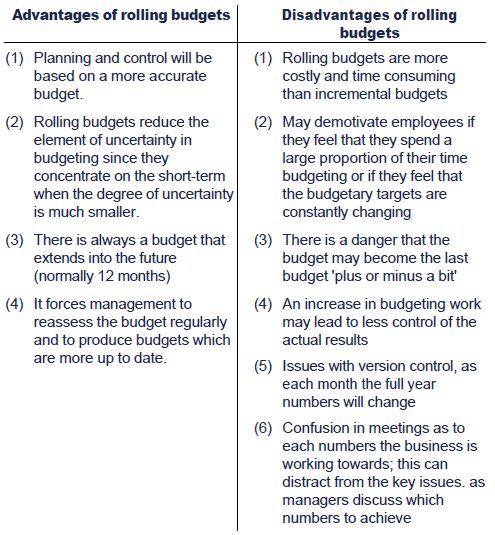

 Test your understanding 9
Test your understanding 9
A company uses rolling budgeting and has a sales budget as follows;

Actual sales for Quarter 1 were $123,450. The adverse variance is fully explained by competition being more intense than expected and growth being lower than anticipated. The budget committee has proposed that the revised assumption for sales growth should be 3% per quarter.
Update the budget as appropriate.

 Activity Based Budgeting
Activity Based Budgeting
ABB is defined as: ‘a method of budgeting based on an activity framework and utilising cost driver data in the budget-setting and variance feedback processes'.
Or, put more simply, preparing budgets using overhead costs from activity based costing methodology.

 Test your understanding 10 - Preparing an ABB
Test your understanding 10 - Preparing an ABB
The operating divisions of Z plc have in the past always used a traditional approach to analysing costs into their fixed and variable components. A single measure of activity was used which, for simplicity, was the number of units produced. The new management does not accept that such a simplistic approach is appropriate for budgeting in the modern environment and has requested that the managers adopt an activity-based approach in future.
Required:
Explain how ABB would be implemented by the operating divisions of Z plc.

The advantages of ABB are similar to those provided by activity-based costing (ABC).
- It draws attention to the costs of ‘overhead activities' which can be a large proportion of total operating costs.
- It recognises that it is activities which drive costs. If we can control the causes (drivers) of costs, then costs should be better managed and understood.
- ABB can provide useful information in a total quality management (TQM) environment, by relating the cost of an activity to the level of service provided.
Disadvantages of ABB
- A considerable amount of time and effort might be needed to establish the key activities and their cost drivers.
- It may be difficult to identify clear individual responsibilities for activities.
- It could be argued that in the short-term many overhead costs are not controllable and do not vary directly with changes in the volume of activity for the cost driver. The only cost variances to report would be fixed overhead expenditure variances for each activity.

 Activity matrix
Activity matrix
An activity-based budget can be constructed by preparing an activity matrix. This identifies the activities in each column, and the resources required to carry out the activities in each row.
The following ‘activity matrix' shows the resources used (rows) and major functions/activities (columns) of a stores department. In this example, all the identified activities occur within a single department.
- The total current annual costs of each resource consumed by the department are shown in the final column; they have then been spread back over the various activities to establish the cost pools. The allocation of resource costs between activities will, to some extent, be subjective.
- Each of the first four activities has an identifiable cost driver, and the total resource cost driver rates can be determined (cost per unit of activity).
- The last two activities that occur within the department are non-volume related, and are sometimes referred to as ‘sustaining costs'. They are necessary functions and should not be ignored in the budgeting process; however, they should not be attributed to particular cost drivers, as this would not reflect their true cost behaviour and would result in inappropriate budgets being set.
Activity cost matrix for stores department
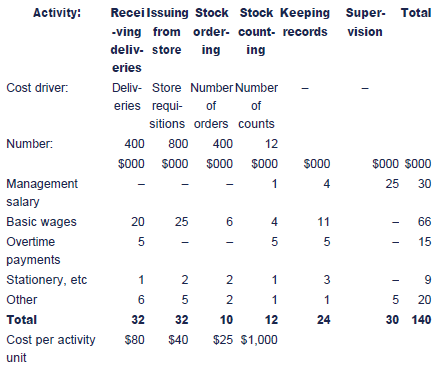
Sustaining costs will effectively be treated as fixed costs. However, for control purposes, activity-based costs can be assumed to be variable, and actual costs can be compared with the expected costs for the given level of activity.


 Test your understanding 11
Test your understanding 11
Which statement is correct regarding the benefits to be gained from using ABB?
A If there is much inefficiency within the operations of a business then ABB will identify and remove these areas of inefficiency.
B In a highly direct labour intensive manufacturing process, an ABB approach will assist management in budgeting for the majority of the production costs.
C In an organisation currently operating efficiently, where the next period will be relatively unchanged from the current one, then ABB will make the budgeting process simpler and quicker.
D If an organisation produces many different types of output using different combinations of activities then ABB can provide more meaningful information for budgetary control.

Feed-forward control
 A feed-forward control system operates by comparing budgeted results against a forecast. Control action is triggered by differences between budgeted and forecasted results.
A feed-forward control system operates by comparing budgeted results against a forecast. Control action is triggered by differences between budgeted and forecasted results.
In contrast, a feedback system would simply compare the actual historical results with the budgeted results.
For example, the graph below shows the feedback and feed-forward system for sales:
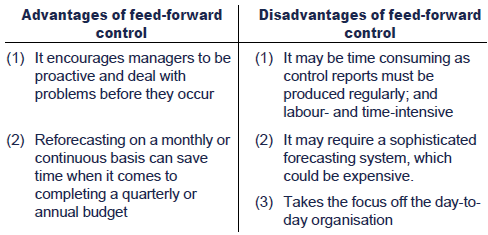

 Illustration 3 – Feed-forward control
Illustration 3 – Feed-forward control
A sales manager receives monthly control reports about sales values. The budgeted sales for the year to 31 December are $600,000 in total. At the end of April the manager might receive the following feedback control report.
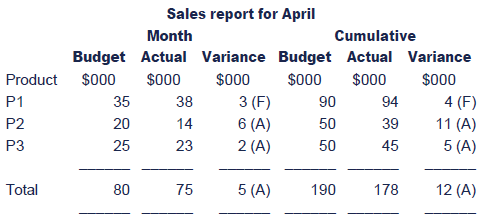
Alternatively, the sales manager might be presented with a feed-forward control report, as follows:
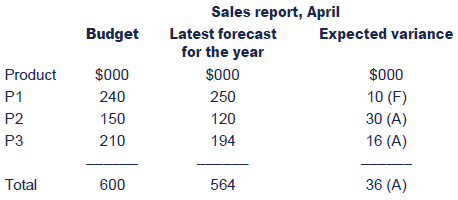
The use of a feed-forward control system means that corrective action can be taken to avoid expected adverse variances.


 Test your understanding 12
Test your understanding 12
Explain why feed-forward control may be particularly appropriate for the capital expenditure budget.

8 Selecting a suitable budgetary system
Introduction
As seen, there are many approaches to budgeting and an organisation will wish to select a system which is most appropriate.
Factors, which will determine suitability include:
- type and size of organisation
- type of industry
- type of product and product range
- culture of the organisation.

 Illustration 4 – Selecting a suitable budgetary system
Illustration 4 – Selecting a suitable budgetary system
A hospital operates in a relatively stable financial environment, has a very high proportion of fixed costs and a diverse range of activities. Factors to consider when selecting a suitable budgetary system may be:
- An incremental approach may be suitable for all routine activities. New ventures may use a zero-based approach.
- The fixed costs may need close control and therefore some form of ABB may be appropriate.
- The culture of the organisation may dictate whether a participative or imposed budgeting style is more effective. If there are managers who are trained in budgeting and costs are mainly controllable then it may be preferable to adopt a participative approach to empower and motivate staff. If costs are mainly uncontrollable it may be preferable to use a centrally controlled, imposed budget.


 Test your understanding 13
Test your understanding 13
Select and justify a suitable budgeting system for a company operating in the mobile phone market.

Information for budgeting
Budgeting requires a great deal of information that can be drawn from many sources.
The main sources of information for budgeting purposes are:
- previous year's actual results
- other internal sources which may include manager's knowledge concerning the state of repair of fixed assets, training needs of staff, long-term requirements of individual customers, etc.
- estimates of costs of new products using methods such as work study techniques and technical estimates.
- statistical techniques such as linear regression (chapter 8) may help to forecast sales.
- models, such as the EOQ model, may be used to forecast optimal inventory levels.
- external sources of information may include suppliers' price lists, estimates of inflation and exchange rate movements, strategic analysis of the economic environment.

 Change factors impacting budgeting
Change factors impacting budgeting
The PESTEL model met in paper F1 is useful for identifying change factors:
Political change
A change in government policy, for example fiscal policy, may affect the demand for an organisation's products, and/or the costs incurred in providing them. Any such changes will affect both short-term and long-term planning. This is one reason why planning is a continuous process.
Social change
Changes in social responsibilities and people's attitude towards them affect every organisation. In recent years there has been much more concern about social responsibilities, some of which are now recognised by law. All of these factors may impinge on the plans of the organisation.
Economic change
When there is a change in the economic climate from boom through to recession, the demands upon people's income become more focused. Money tends to be spent on necessary goods with little left for ‘luxury goods' and savings. The lack of savings deters investment, with the result that plans have to be modified if they are to be realistic targets.
Technological change
When plans are made, they are based upon the use of certain methods and equipment. As technology advances, the older methods are proven to be inefficient, with the result that decisions are taken to update the operation. As a consequence, the aspects of the budgets and plans which related to the old method are no longer relevant. Revised plans must now be drawn up on the basis of the new technology.
Legal change
When plans are made they are based on the current legal framework and known changes to this are also factored in over time. However, changes to the legal framework can cause information that is used when pulling budgets together to become redundant. An example of this might be the government introducing legislation that bans fast food from being advertised during the intervals between children's TV programmes.


 Test your understanding 14
Test your understanding 14
Describe the sources of information required for a company's cash budget.

Changing a budgetary system
A change in the budgetary system could bring about improved planning, control and decision making.
However, before a change is made the following issues should be considered:
- Are suitably trained staff available to implement the change successfully?
- Will changing the system take up management time which should be used to focus on strategy?
- All staff involved in the budgetary process will need to be trained in the new system and understand the procedure to be followed in changing to the new approach. A lack of participation and understanding builds resistance to change.
- All costs of the systems change, e.g. new system costs, training costs, should be evaluated against the perceived benefits. Benefits may be difficult to quantify and therefore a rigorous investment appraisal of the project may be difficult to prepare.

 Test your understanding 15
Test your understanding 15
A large holiday complex currently uses incremental budgeting but is concerned about its very high proportion of overhead costs and is considering changing to an activity based budgeting system. Demand follows a fairly predictable seasonal pattern.
Discuss the issues that should be considered before changing to a new budgetary system.

Dealing with uncertainty in budgeting
Budgets are open to uncertainty. For example, non-controllable factors such as a recession or a change in prices charged by suppliers will contribute to uncertainty in the budget setting process.
There are several techniques available to help deal with uncertainty. These have been discussed before and include:
- Flexible budgets : these are budgets which, by recognising different cost behaviour patterns, are designed to change as the volume of activity changes. Flexible budgets are prepared under marginal costing principles, and so mixed costs are split into their fixed and variable components. This is useful at the control stage : it is necessary to compare actual results to the actual level of activity achieved against the results that should have been expected at this level of activity - which are shown by the flexible budget (more on next chapter).
- Rolling budgets: the budget is updated regularly and, as a result, uncertainty is reduced.
- Sensitivity analysis: variables can be changed one at a time and a large number of budgets produced. For example, what would happen if the actual sales volume was only 75% of the budgeted amount?
- Simulation: similar to sensitivity analysis but it is possible to change more than one variable at a time.
 Spreadsheets
Spreadsheets
A spreadsheet is a computer package which stores data in a matrix format where the intersection of each row and column is referred to as a cell. They are commonly used to assist in the budgeting process.
Advantages of spreadsheets
- Large enough to include a large volume of information
- Formulae and look up tables can be used so that if any figure is amended, all the figures will be immediately recalculated. This is very useful for carrying out sensitivity analysis.
- The results can be printed out or distributed to other users electronically quickly and easily.
- Most programs can also represent the results graphically e.g. balances can be shown in a bar chart:
- Closing cash balances
Disadvantages of spreadsheets:
- Spreadsheets for a particular budgeting application will take time to develop. The benefit of the spreadsheet must be greater than the cost of developing and maintaining it.
- Data can be accidentally changed (or deleted) without the user being aware of this occurring.
- Errors in design, particularly in the use of formulae, can produce invalid output. Due to the complexity of the model, these design errors may be difficult to locate.
- Data used will be subject to a high degree of uncertainty. This may be forgotten and the data used to produce, what is considered to be, an 'accurate' report.
- Security issues, such as the risk unauthorised access (e.g. hacking) or a loss of data (e.g. due to fire or theft).
- Version control issues can arise.
- Educating staff to use spreadsheets / models and which areas /cells to use as inputs can be time consuming.

 Illustration 5 – Using spreadsheets in budgeting
Illustration 5 – Using spreadsheets in budgeting
When producing a master budget manually the major problem is ensuring that any initial entry in the budget or any adjustment to a budget item is dealt with in every budget that is relevant – in effect, budgets need to comply with normal double entry principles to be consistent.
Suppose, for instance, that sales in the last month were expected to rise by $10,000, what adjustments would be necessary?
Using spreadsheets all of the above adjustments could be processed automatically if the relevant formulae were set up properly. Receivables, cost of sales, purchases, payables, cash, inventory and profit could change instantly on adjusting sales of month 12.

9 Chapter summary
Test your understanding answers

 Test your understanding 1 - Evaluation of managers
Test your understanding 1 - Evaluation of managers
The key point here is that the answer depends on who awarded the pay increase.
If this was the production manager's decision, then the cost would be controllable. Depending on the culture of the firm, the manager would then be under pressure to explain why they departed from the budget in this instance.
If awarded by, say, the board of directors, then the cost increase was not controllable by the manager and should not feature in their appraisal.
Note: The concept of controllability is important for the exam.


 Test your understanding 2
Test your understanding 2
The manager may try to:
- delay discretionary short-term expenditure, e.g. maintenance, at the expense of long-term performance to improve results.
- manipulate results to make sure the relevant targets are achieved.
- incorporate budgetary slack into the targets to make them easier to achieve.
The process can be improved by measuring performance against a variety of targets, including non-financial targets, and linking performance to long-term objectives.


 Test your understanding 3
Test your understanding 3
Sales are expected to be $550,000 ×110% × 103% = $623,150. The manager may accept this as a fair target for performance appraisal, planning and control purposes. To encourage the manager to improve further an aspirations target incorporating a further improvement, say to $650,000, could be used and linked to the reward system.


 Test your understanding 4
Test your understanding 4
The key issue is short-termism - the manager may act to increase profit for this period (thus increasing his final bonus) without any consideration of longer term implications. These could include:
- cutting R&D
- cutting marketing expenditure
- cutting back on training
- rejecting projects that do not have high returns in year 1
- sacking non-core staff.
It will be difficult to link the bonus to a longer time scale as the manager will have retired. Instead a non-accounting style focussing on quality, productivity, brand awareness, market share, etc could be adopted, if not already in place.


 Test your understanding 5
Test your understanding 5
(1) Operational managers may not have the knowledge and experience to set a budget. For example, in a small business only the owner may be involved in all aspects of the business and may therefore set the budget.
(2) In times of crisis there may be insufficient time to set a participative budget and targets may have to be imposed to ensure survival.
(3) Participation has to be genuine for it to result in improved motivation. Pseudo-participation, where senior managers seek the opinions of the ultimate budget holders but do not act on these views, may lead to demotivation.


 Test your understanding 6
Test your understanding 6



 Test your understanding 7
Test your understanding 7
Stage 1: Managers should specify the activities that can be evaluated
The managers/researchers responsible for each project should decide which projects they wish to undertake in the forthcoming period. These projects will be a mixture of continued projects and new projects.
Stage 2: Each activity is described in a decision package
For the projects which have already been started and which the managers want to continue in the next period, we should ignore any cash flows already incurred (they are sunk costs), and we should only look at future costs and benefits. Similarly, for the new projects we should only look at the future costs and benefits.
Stage 3: Each decision package is evaluated and ranked
Different ways of achieving the same research goals should also be investigated and the projects should only go ahead if the benefit exceeds the cost.
Stage 4: Resources are allocated to the various packages
Once all the potential projects have been evaluated if there are insufficient funds to undertake all the worthwhile projects, then the funds should be allocated to the best projects on the basis of a cost-benefit analysis.
ZBB is usually of a highly subjective nature. (The costs are often reasonably certain, but usually a lot of uncertainty is attached to the estimated benefits.) This can be shown by the example of a research division where the researchers may have their own pet projects, which they are unable to view in an objective light.


 Test your understanding 8
Test your understanding 8
Stage 1: Managers should specify the activities that can be evaluated
The managers/researchers responsible for each project should decide which projects they wish to undertake in the forthcoming period. These projects will be a mixture of continued projects and new projects.
Stage 2: Each activity is described in a decision package
For the projects which have already been started and which the managers want to continue in the next period, we should ignore any cash flows already incurred (they are sunk costs), and we should only look at future costs and benefits. Similarly, for the new projects we should only look at the future costs and benefits.
Stage 3: Each decision package is evaluated and ranked
Different ways of achieving the same research goals should also be investigated and the projects should only go ahead if the benefit exceeds the cost.
Stage 4: Resources are allocated to the various packages
Once all the potential projects have been evaluated if there are insufficient funds to undertake all the worthwhile projects, then the funds should be allocated to the best projects on the basis of a cost-benefit analysis.
ZBB is usually of a highly subjective nature. (The costs are often reasonably certain, but usually a lot of uncertainty is attached to the estimated benefits.) This can be shown by the example of a research division where the researchers may have their own pet projects, which they are unable to view in an objective light.


 Test your understanding 9
Test your understanding 9
The revised budget should incorporate 3% growth starting from the actual sales figure of Quarter 1 and should include a figure for Quarter 1 of the following year.



 Test your understanding 10 - Preparing an ABB
Test your understanding 10 - Preparing an ABB



 Test your understanding 11
Test your understanding 11
D is the correct answer.
Situation A would be best suited by implementing Zero Base Budgeting. Situation B does not require ABB since it has relatively low overheads. Situation C would be suitable for incremental budgeting. ABB will certainly not be quicker.


 Test your understanding 12
Test your understanding 12
Capital expenditure is often long-term in nature. It is more useful to compare actual costs to forecast completion costs so that action can be taken when a project is in progress rather than waiting for completion.


 Test your understanding 13
Test your understanding 13
The mobile phone market is intensely competitive so a company will need sophisticated systems to gather information about the market and competitors. The market is also fast changing so a rolling budget approach may be suitable to keep budget targets up to date. It will be very important to incorporate the latest information into budgets and a participative approach will be important as production managers and sales managers may have local knowledge which would improve the budgeting process.


 Test your understanding 14
Test your understanding 14
Internal information will be required from the:
- sales department relating to volume and estimated collection periods
- the production manager will estimate material, labour and overhead usage
- the purchasing manager will estimate material prices and payment terms
- human resources will forecast pay rates, bonus payments and overtime requirements
- the finance office may forecast payments of interest, dividends and general office costs.
External information may be required relating to forecast interest rates, tax rates, payment terms for tax, exchange rates, inflation, etc.


 Test your understanding 15
Test your understanding 15
An analysis of overheads should be carried out to determine the proportion that have identifiable cost drivers which differ from the normal volume related cost drivers which may be used when carrying out incremental budgeting. If a substantial volume of overhead is non-volume related then implementing ABB may lead to more accurate planning and control.
Issues, which should then be considered include:
- the development or purchase of a suitable computer system to support an ABB process;
- training of staff to operate and interpret the information produced;
- development of an implementation plan and whether this should run in tandem with the existing process for a trial period.

|
Created at 5/24/2012 4:40 PM by System Account
(GMT) Greenwich Mean Time : Dublin, Edinburgh, Lisbon, London
|
Last modified at 6/7/2012 4:24 PM by System Account
(GMT) Greenwich Mean Time : Dublin, Edinburgh, Lisbon, London
|
|
|
|
 |
Rating
:
|
 Ratings & Comments
(Click the stars to rate the page) Ratings & Comments
(Click the stars to rate the page)
|
 |
Tags:
|
|
|
|
|